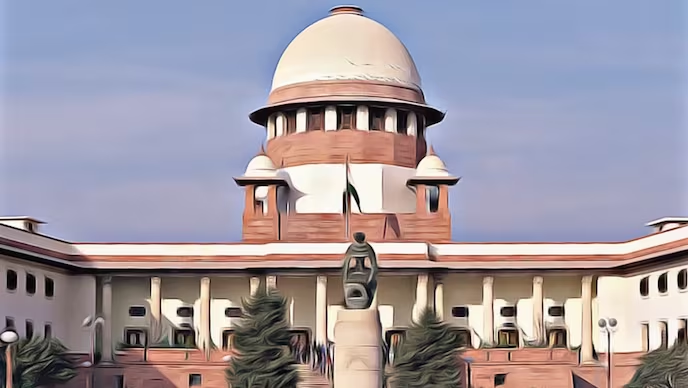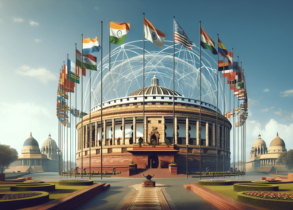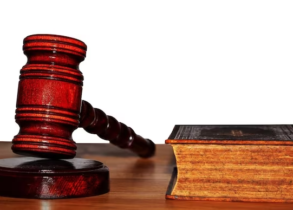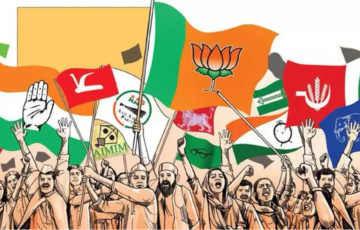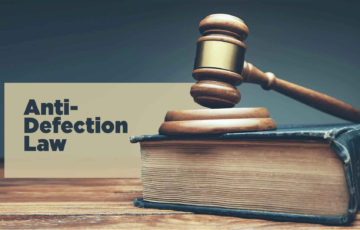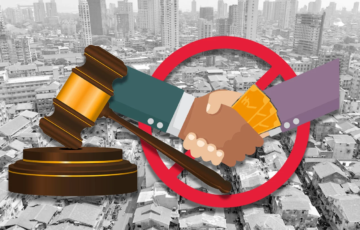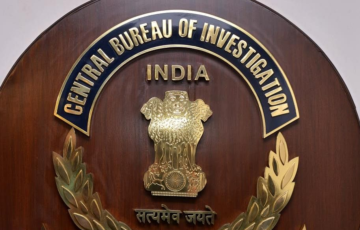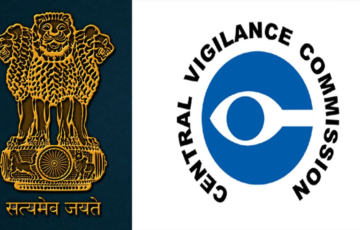SUPREME COURT
Historical Background
- The Supreme Court in Calcutta was established as a Court of Record with full jurisdiction under the Regulating Act of 1773. It had authority over criminal charges and cases in Bengal, Bihar, and Orissa. King George III later created the Supreme Courts of Madras and Bombay in 1800 and 1823, respectively.
- The India High Courts Act of 1861 introduced High Courts in various provinces, leading to the abolition of the Supreme Courts in Calcutta, Madras, and Bombay, along with the Sadar Adalats in Presidency towns. Until the Federal Court of India was founded in 1935 under the Government of India Act, these High Courts held the highest authority in all cases.
- The Federal Court was responsible for resolving conflicts between provinces and federal states and hearing appeals from High Court decisions. Finally, the Constitution of India came into effect on January 26, 1950, after India’s independence in 1947. The Supreme Court of India was established, commencing its operations on January 28, 1950.
Constitutional Provisions
- Part V of the Indian Constitution, specifically Chapter 6, deals with the provisions for the Supreme Court, which consists of Articles 124 to 147. This section outlines the organization, independence, jurisdiction, powers, and procedures of the Supreme Court of India.
- Article 124(1) of the Indian Constitution establishes the Supreme Court of India, consisting of a Chief Justice of India (CJI) and not more than seven additional judges unless Parliament, by law, prescribes a larger number.
- The Supreme Court’s jurisdiction can be categorized into three types: original jurisdiction, appellate jurisdiction, and advisory jurisdiction. It also possesses a wide range of powers.
- One crucial aspect is that the Supreme Court’s decisions are binding on all courts within India’s jurisdiction. This ensures uniformity and consistency in the application of the law.
- Additionally, the Supreme Court holds the authority of judicial review. This power enables it to invalidate legislative and executive actions that contravene the provisions and scheme of the Constitution, upset the power balance between the Union and the States, or infringe upon the fundamental rights protected by the Constitution.
Composition and Appointment
- The appointment of judges to the Supreme Court is a crucial aspect of the Indian legal system. The President of India is responsible for appointing these judges.
- According to the provisions in the Constitution, the Chief Justice of India (CJI) is appointed by the President after consultation with the judges of the Supreme Court and the high courts, as deemed necessary. For the appointment of other judges, the President consults the CJI and such other judges of the Supreme Court and high courts as he deems necessary. It’s noteworthy that in the case of appointing a judge other than the Chief Justice, consultation with the Chief Justice is obligatory.
|
Debate over Consultation
- However, the term “consultation” has been a subject of controversy and legal interpretation. In the First Judges case (1982), the Supreme Court held that “consultation” does not imply “concurrence” and simply implies an exchange of views.
- But this interpretation changed in the Second Judges case (1993) when the Supreme Court reversed its earlier stance, ruling that the advice tendered by the Chief Justice of India is binding on the President in matters of appointing judges to the Supreme Court. The Chief Justice is required to consult with two of his seniormost colleagues.
- In the Third Judges case (1998), the Court opined that the consultation process should involve a “consultation of plurality judges.” The Chief Justice of India must consult a collegium of the four seniormost judges of the Supreme Court. Even if two judges provide an adverse opinion, the recommendation should not be sent to the government. Recommendations made without adhering to these norms and requirements are not binding on the government.
Collegium System in India
- The Collegium System in India, often referred to as “Judges-Selecting-Judges,” is a mechanism in which judges are chosen and transferred solely by their fellow judges. This system has developed through Supreme Court decisions rather than being established by an Act of Parliament or a Constitutional provision.
- The Supreme Court Collegium is headed by the Chief Justice of India and includes the four most senior justices of the Supreme Court. The purpose of this system is to enhance and streamline the appointment process, ensuring that the Chief Justice’s opinion is formed collectively by a group of senior judges in the court, rather than being an individual decision.
- In practice, the Collegium makes recommendations to the Central Government regarding the appointment or transfer of lawyers or judges. The Central Government may suggest some names, and the Collegium reviews these suggestions before sending back the dossier to the government for final approval.
- If the Collegium reiterates the same name to the Government twice, the Government is obligated to approve the nomination. However, there is no specified time limit for the Government to respond, which can make the process of appointing judges quite lengthy.
| The 99th Constitutional Amendment Act |
|
Issues Associated with Collegium
- The collegium system has been criticized for a number of reasons, including:
- Lack of transparency: The collegium’s decision-making process is opaque and there is no public scrutiny of its decisions.
- Nepotism and favouritism: There have been allegations of nepotism and favouritism in the collegium’s selection process.
- Lack of diversity: The collegium has been criticized for not appointing enough judges from marginalized groups, such as women, Scheduled Castes, and Scheduled Tribes.
- Delay in appointments: The collegium system has been blamed for the delay in appointments to the Supreme Court and High Courts.
- Example: In 2017, the Supreme Court recommended the appointment of Justice K.M. Joseph to the Supreme Court. However, the government refused to accept the recommendation. The government’s refusal to appoint Justice Joseph was widely seen as an attempt to interfere with the independence of the judiciary.
Appointment of CJI
- The appointment of the Chief Justice of India (CJI) from 1950 to 1973 generally followed the convention of appointing the senior most judge of the Supreme Court as the CJI. However, this practice was disrupted in 1973 when A.N. Ray was appointed as the CJI, superseding three senior judges. A similar situation arose in 1977 when M.U. Beg was appointed as the CJI, bypassing the then senior-most judge.
- To address this issue, the Supreme Court intervened and provided guidance on the appointment of the CJI in the Second Judges Case (1993). In this landmark case, the Supreme Court ruled that the senior most judge of the Supreme Court should be appointed as the CJI. This decision aimed to establish a more predictable and consistent approach to the appointment of the CJI, ensuring that the principle of seniority is respected and that the process is free from executive discretion.
Qualifications and Oath
| Qualifications | The qualifications for a judge of the Supreme Court of India, as specified in the Constitution of India (Article 124), are as follows:
· Citizenship: The person must be a citizen of India. · Judicial Experience: To be eligible for appointment as a judge of the Supreme Court, a candidate should have served as a judge of a high court for a minimum of five years or should have been an advocate in a high court for a period of ten years. · Distinguished Jurist: In the case of a candidate who has been an advocate, they should also have an excellent knowledge of constitutional law and legal matters. |
| Oath | · A Supreme Court judge, upon appointment, takes an oath or affirmation before the President or a designated official. In this oath, they pledge loyalty to the Indian Constitution, uphold India’s sovereignty and integrity, commit to faithfully performing their duties without bias, and vow to uphold the Constitution and laws. |
Tenure of Supreme Court Judges
- The tenure and conditions of service of a Supreme Court judge in India are not explicitly specified in the Constitution. However, certain provisions and practices govern their terms of office:
- Retirement Age: A judge of the Supreme Court serves until they reach the age of 65. Any questions or disputes about a judge’s age are resolved by the authority of Parliament, following procedures determined by Parliament.
- Resignation: A judge can choose to resign from their position by submitting a letter of resignation to the President.
- Removal: The President has the power to remove a Supreme Court judge from office based on the suggestion of Parliament. The specific grounds and procedures for removal are determined by law.
- Financial Independence: The salaries of Supreme Court judges and administrative expenditures related to the functioning of the Supreme Court are charged to the Consolidated Fund of India. This means that they are not subject to parliamentary approval, ensuring the financial independence of the judiciary.
- Post-Retirement Restrictions: After retirement, Supreme Court judges are prohibited from practicing law or acting in any court or before any authority within the territory of India. This rule aims to maintain the impartiality and integrity of former judges.
- These provisions and practices are in place to ensure the independence, integrity, and efficient functioning of the judiciary in India.
Removal of Supreme Court Judges
- The process of removing a Supreme Court judge in India is a rigorous and constitutionally established one, and it is governed by specific rules:
- Impeachment Process: A Supreme Court judge can be removed through the process of impeachment. This process begins with a motion for impeachment introduced in either the Lok Sabha (House of the People) or the Rajya Sabha (Council of States).
- Presidential Order: If the motion for impeachment is approved by a special majority in both Houses of Parliament, a Presidential order is issued for the removal of the judge.
- Special Majority Approval: To pass the impeachment motion, a special majority is required in each House, which means it must be approved by a majority of the total membership of that House and by a majority of not less than two-thirds of the members of that House present and voting.
- Grounds for Removal: A judge can be removed only on two grounds: proven misbehavior or incapacity.
- Judges Enquiry Act: The process of impeachment is governed by the Judges Enquiry Act of 1968, which outlines the procedures and requirements for initiating and conducting such inquiries.
|
Under the Judges Enquiry Act (1968), the procedure for removing a Supreme Court judge through impeachment involves several steps: o A removal motion, signed by at least 100 Lok Sabha members or 50 Rajya Sabha members, is submitted to the Speaker/Chairman. o The Speaker/Chairman reviews the motion for compliance and order. o If found in order, the motion is admitted, circulated to members, and a consideration date is set. o An inquiry committee, including judges and experts, is established to investigate the allegations. o The committee submits a report on its findings. o The motion is debated in the respective house. o A vote is taken, requiring a special majority for approval. o If both houses approve, the motion is sent to the President for consent. o Upon Presidential approval, the judge may be dismissed or may choose to resign. Notably, no Supreme Court judge has been successfully impeached so far. |
|
Do You Know? |
|
It’s important to note that, as of now, no Supreme Court justice in India has been impeached. Impeachment motions against specific judges, such as Justice V. Ramaswami (1991–1993) and Justice Dipak Misra (2017–2018), did not succeed in Parliament. The stringent requirements for impeachment reflect the importance of judicial independence and the need for a comprehensive and well-substantiated case for removal. |
Acting, ADHOC and Retired Judges
Acting Chief Justice
- The President of India has the authority to appoint a judge of the Supreme Court as an acting Chief Justice of India under the following circumstances:
- Vacancy in the Office of Chief Justice of India: When the office of the Chief Justice of India is vacant, the President can appoint an acting Chief Justice to ensure the continuity of the judiciary’s functioning.
- Temporary Absence of the Chief Justice of India: In situations where the Chief Justice of India is temporarily absent from the office, the President can appoint an acting Chief Justice to perform the duties during the Chief Justice’s absence.
- Inability of the Chief Justice to Perform Duties: If the Chief Justice of India is unable to perform the duties of the office for any reason, the President can appoint an acting Chief Justice to fulfill those responsibilities.
ADHOC Judges
- Article 127 of the Indian Constitution provides for the appointment of ad hoc judges to the Supreme Court under specific circumstances:
- Quorum Requirement: When there is a need to maintain a quorum of permanent judges for the Supreme Court to hold or continue a session, the Chief Justice of India may appoint a judge from a High Court as an ad hoc judge of the Supreme Court.
- Consultation and Approval: The appointment of an ad hoc judge can only be made after the Chief Justice of India consults with the chief justice of the relevant High Court and receives prior approval from the President of India.
- Eligibility: The judge selected as an ad hoc judge must meet the eligibility criteria to serve on the Supreme Court.
- Duties and Jurisdiction: An ad hoc judge appointed in this manner is obliged to attend Supreme Court sittings. While doing so, they possess all the jurisdiction, powers, and privileges, and fulfill the duties of a regular Supreme Court judge.
- Purpose: The provision for ad hoc judges helps ensure that the Supreme Court can function effectively even in situations where the number of permanent judges available may be insufficient to constitute a quorum. It is a mechanism to address temporary gaps in the Supreme Court’s composition to ensure the smooth dispensation of justice.
Retired Judge
- Article 128 of the Indian Constitution addresses the provision for the attendance of retired judges at sittings of the Supreme Court:
- Proposal by the Chief Justice: The Chief Justice of India has the authority to propose that a retired Supreme Court judge or a retired judge of a high court, who is legally eligible for appointment as a Supreme Court judge, sits as a judge of the Supreme Court for a short duration.
- Approval Required: The Chief Justice can make such a proposal only with the prior approval of both the President of India and the person to be nominated as a sitting judge.
- Entitlement to Allowances: A retired judge nominated to sit as a judge of the Supreme Court is entitled to receive allowances as determined by the President.
- Jurisdiction and Powers: During the term as a sitting judge, the nominated retired judge possesses all the jurisdiction, powers, and privileges of a Supreme Court judge. However, it’s important to note that the retired judge does not assume the title or status of a regular Supreme Court justice.
Seat
- The Constitution designates Delhi as the seat of the Supreme Court. The Chief Justice of India has the option, with the President’s approval, to appoint another location as a seat, but this provision is not mandatory and is at the discretion of the authorities. Courts cannot be compelled to change the Supreme Court’s seat.
Procedure
- The Supreme Court of India, with the President’s consent, can establish rules governing its general practices and procedures. Here are some key practices of the Supreme Court:
| Constitutional Cases | Constitutional cases or references initiated by the President under Article 143 of the Constitution are decided by a bench of at least five judges. In all other situations, a bench of at least three judges is typically employed to reach a decision.
|
| Open Court Verdicts | The Supreme Court’s decisions are pronounced in open court, ensuring transparency in the judicial process. |
| Majority Vote | All decisions are reached through a majority vote among the participating judges. In cases where there is a difference of opinion among judges, they have the option to provide dissenting judgments or opinions. |
- These practices ensure that the Supreme Court operates in a transparent and democratic manner, with decisions made through majority consensus while allowing for dissenting views when necessary.
Independence of Supreme Court
- The Supreme Court plays a vital role in the Indian democratic system, serving as a federal court, the highest court of appeal, protector of citizens’ fundamental rights, and guardian of the Constitution. Its independence is crucial for effectively fulfilling its assigned duties, free from interference by the executive and legislative branches. To ensure this independence, the Constitution includes the following provisions:
- Appointment Procedure: Judges are appointed in consultation with the judiciary, minimizing political influence.
- Security of Tenure: They can only be removed according to procedures outlined in the Constitution.
- Fixed Service Conditions: Salary, allowances, and service conditions are protected, with alterations only possible during financial emergencies.
- Expenses from Consolidated Fund: Funding for salaries, pensions, and administrative costs is not subject to parliamentary votes.
- Conduct of Judges: The Constitution bars any discussion in Parliament or State Legislatures concerning the conduct of Supreme Court judges in the execution of their duties, except during impeachment proceedings.
- Post-Retirement Practice: Retired Supreme Court judges are forbidden from practicing in any Indian court or before any authority, preventing potential biases in anticipation of future favors.
- Contempt Powers: The Supreme Court can take legal action against anyone for contempt, ensuring that its actions and decisions are respected without criticism or opposition.
- Staff Appointment Freedom: The Chief Justice of India can appoint Supreme Court officers and staff without executive interference and set their service conditions.
- Jurisdiction Protection: The Parliament is not empowered to limit the Supreme Court’s jurisdiction and authority, although it can expand it if needed.
- Separation of Powers: The Constitution mandates the separation of the judiciary from the executive in public services, ensuring that the executive does not have judicial powers, thereby ending the executive’s role in judicial administration.
Jurisdiction of Supreme Court
The Supreme Court of India has been conferred with a wide and extensive jurisdiction under the Indian Constitution. Its jurisdiction encompasses several categories, including:
Original Jurisdiction
- Disputes between the Centre and One or More States: When there is a conflict between the central government and one or more states, the Supreme Court is the sole authority to adjudicate.
- Disputes Involving the Centre and States vs. Other States: Conflicts that involve the central government and one or more states on one side and one or more other states on the other are also heard exclusively by the Supreme Court.
- Inter-State Disputes: Disagreements between two or more states, such as disputes over borders or resources, fall under the exclusive original jurisdiction of the Supreme Court.
Supreme Court’s Original Jurisdiction Exclusions:
- Pre-Constitutional Agreements: Disputes arising from treaties, agreements, covenants, or other instruments made before the Indian Constitution came into effect are not within the Supreme Court’s original jurisdiction.
- Explicit Jurisdiction Exclusions: If a treaty, agreement, or any other pact explicitly states that the Supreme Court’s jurisdiction doesn’t extend to a particular matter, the court won’t have original jurisdiction in such cases.
- Water Disputes: Disputes related to the sharing of water resources between states are subject to a separate mechanism and are not resolved through the Supreme Court’s original jurisdiction.
- Referrals to the Finance Commission: Matters referred to the Finance Commission for financial recommendations are not under the Supreme Court’s original jurisdiction.
- Expense and Pension Adjustments: Certain financial adjustments and pension-related disputes between the central government and states are not within the Supreme Court’s original jurisdiction.
- Commercial Disputes: Ordinary commercial conflicts between the Centre and the states are not handled through the Supreme Court’s original jurisdiction.
- State Claims for Damages: When a state seeks compensation or damages from the central government, it does not come under the Supreme Court’s original jurisdiction.
- Appellate Jurisdiction: The Supreme Court acts as the highest court of appeal in the country. Its appellate jurisdiction extends to:
- Appeals from the judgments and orders of high courts.
- Appeals from tribunals or other judicial bodies established by law.
- Appeals in both civil and criminal matters.
- There is no inherent or constitutional limit on the Supreme Court’s appellate jurisdiction, making it the ultimate court for all legal disputes.
Advisory Jurisdiction:
- Reference on Questions of Law or Fact of Public Importance:
- The President can seek the Supreme Court’s opinion on any question of law or fact of public importance that has arisen or is likely to arise.
- The Supreme Court may or may not submit its opinion to the President in this case.
- The opinion given by the Supreme Court is advisory and not binding.
- Reference on Pre-Constitutional Treaties or Agreements:
- The President can also refer any pre-constitutional treaty, agreement, covenant, engagement, or similar instruments to the Supreme Court if they give rise to a dispute.
- In this case, the Supreme Court is required to submit its opinion to the President.
- Like the first type of reference, the opinion provided by the Supreme Court in this context is advisory and not binding.
- In both cases, the Supreme Court’s role is to provide its expert opinion on the matter in question. However, the President is not obligated to follow the Supreme Court’s opinion and can choose to either accept or disregard it. This process allows the President to seek legal and constitutional guidance on complex issues of public importance while maintaining the separation of powers in the Indian democratic system.
Writ Jurisdiction:
Supreme Court’s Writ Jurisdiction:
- The Supreme Court has the authority to grant writs, such as habeas corpus, mandamus, prohibition, quo-warranto, and certiorari, to protect fundamental rights.
- This jurisdiction is categorized as original, which means that an aggrieved person can directly approach the Supreme Court without going through the appeals process.
- The Supreme Court’s writ jurisdiction is exclusively for enforcing fundamental rights.
High Courts’ Writ Jurisdiction:
- High Courts also have the authority to issue writs to protect fundamental rights.
- High Courts, however, have a broader writ jurisdiction compared to the Supreme Court. They can issue writs for various reasons, not limited to the enforcement of fundamental rights.
Parliament’s Authority to Extend Writ Jurisdiction:
- Parliament can grant the Supreme Court the power to issue writs for reasons other than the enforcement of fundamental rights.
- This distinction between the Supreme Court and High Courts in terms of writ jurisdiction ensures that access to justice and the enforcement of fundamental rights can occur at both the federal and state levels in India, depending on the nature and scope of the case.
Appellate Jurisdiction
- Appeals in Constitutional Matters:
- Appeals in constitutional cases can be made to the Supreme Court if the High Court certifies that the case involves a substantial point of law requiring constitutional interpretation.
- Either side in the case can appeal to the Supreme Court based on this certificate, arguing that the question was incorrectly decided.
- Appeals in Civil Matters:
- In civil disputes, any judgment of a high court can be appealed to the Supreme Court if the high court certifies two conditions:
- The case contains a substantial question of law of general importance.
- The question requires the Supreme Court’s decision.
- Appeals in Criminal Matters: The Supreme Court hears appeals in criminal cases from a high court’s decision if:
- The high court has reversed an order of acquittal of an accused person and sentenced them to death on appeal.
- The high court has taken a case from any subordinate court, convicted the accused person, and sentenced them to death.
- The high court certifies that the case is suitable for appeal.
- Discretionary Power: The Supreme Court has the discretion to grant special leave to appeal. It cannot be claimed as an inherent right, and the Court decides whether to grant such leave.
- Final or Interlocutory Judgments: Special leave can be awarded in response to any judgment, be it a final judgment or an interlocutory judgment.
- Scope of Matters: Special leave can be granted for a wide range of legal matters, including those of constitutional, civil, criminal, income-tax, labor, revenue, attorneys, and other types.
- Applicability to Various Courts and Tribunals: Special leave can be granted against judgments from any court or tribunal in the country, not limited to high courts. The exception is military tribunals and court-martial decisions.
Court of Record
- The Supreme Court holds two important powers as a Court of Record:
- Recording of Decisions: The Supreme Court’s decisions, proceedings, and actions are meticulously recorded for future reference and as legal evidence. These records carry significant evidential value and are considered as authoritative precedents and references in the field of law.
- Contempt of Court Authority: The Supreme Court has the authority to deal with cases of contempt of court. This authority extends not only to the Supreme Court itself but also to High Courts, subordinate courts, and tribunals throughout the country.
- Contempt of court can take two forms:
- Civil Contempt: This pertains to willful disobedience of a court’s judgment, order, writ, or other legal processes, or the willful breach of an undertaking given to a court.
- Criminal Contempt: Criminal contempt involves the publication of any matter or the engagement in any conduct that scandalizes or undermines a court’s authority, tends to bias or obstruct the proper conduct of a judicial proceeding, or interferes with the administration of justice in any other manner.
Power of Judicial Review
- The power of judicial review allows the Supreme Court to examine the constitutionality of legislative enactments at both the federal and state levels, as well as the actions of the President. If any of these are found to be in violation of the Constitution (ultra vires), the Supreme Court can declare them illegal, unconstitutional, and void, rendering the government incapable of enforcing them.
Constitutional Interpretation
- The Supreme Court serves as the ultimate authority in the interpretation of the Constitution. It has the authority to provide the final interpretation of the meaning and content of the Constitution’s provisions, including the language used in the document. This means the Supreme Court has the last say on the spirit and intent of the Constitution.
Other Powers
- Resolution of Disputes: It resolves disputes related to the election of the President and Vice-President with original, exclusive, and final authority.
- Investigation of Misbehavior: Upon the President’s request, it investigates the conduct and behavior of the Chairman and members of the Union Public Service Commission. If they are found guilty of misbehavior, the Supreme Court can recommend their dismissal to the President, and the President is bound by this recommendation.
- Review of Its Own Decisions: The Supreme Court can review its own decisions or orders, allowing it to deviate from earlier judgments in the interests of justice or societal welfare.
- Transfer of Cases: It has the power to transfer cases from one High Court to another or decide matters withdrawn from the High Courts.
- Binding Authority: Its decisions and orders are binding on all Indian courts and hold jurisdiction across the entire country. All civil and judicial authorities are required to support and enforce the Supreme Court’s decisions.
- Judicial Supervision: The Supreme Court exercises judicial supervision and control over all courts and tribunals operating throughout the country.
- Expansion of Authority: Parliament can expand the Supreme Court’s jurisdiction over topics in the Union list, and special agreements between the Centre and states can extend its authority in additional areas.
| Recent Issues |
|
UPSC PREVIOUS YEAR QUESTION
1. Consider the following statements:
1. Statement-I: The Supreme Court of India has held in some judgments that the reservation policies made under Article 16(4) of the Constitution of India would be limited by Article 335 for maintenance of efficiency of administration.
2. Statement-II: Article 335 of the Constitution of India defines the term ‘efficiency of administration’.
2. Which one of the following is correct in respect of the above statements?
(a) Both Statement-I and Statement-II are correct and Statement-II is the correct explanation for Statement-I
(b) Both Statement-I and Statement-II are correct and Statement-II is not the correct explanation for Statement-1
(c) Statement-I is correct but Statement-II is incorrect
(d) Statement-I is incorrect but Statement-II is correct
3. Consider the following statements: (2022)
1. Pursuant to the report of H.N. Sanyal Committee, the Contempt of Courts Act, 1971 was passed.
2. The Constitution of India empowers the Supreme Court and the High Court to punish for contempt of themselves.
3. The Constitution of India defines Civil Contempt and Criminal Contempt.
4. In India, the Parliament is vested with the powers to make laws on Contempt of Court.
Which of the above statements given above is/are correct?
(a) 1 and 2 only
(b) 1, 2 and 4
(c) 3 and 4 only
(d) 3 only
4. With reference to India, consider the following statements: (2022)
1. Government law officers and legal firms are recognised as advocates, but corporate lawyers and patent attorneys are excluded from recognition as advocates.
2. Bar Councils have the power to lay down the rules relating to legal education and recognition of law colleges.
Which of the statements given above is/are correct?
(a) 1 only
(b) 2 only
(c) Both 1 and 2
(d) Neither 1 nor 2
5. With reference to Indian judiciary, consider the following statements: (2021)
1. Any retired judge of the Supreme Court of India can be called back to sit and act as a Supreme Court judge by the Chief Justice of India with prior permission of the President of India.
2. A High Court in India has the power to review its own judgement as the Supreme Court does.
Which of the statements given above is/are correct?
(a) 1 only
(b) 2 only
(c) Both 1 and 2
(d) Neither 1 nor 2
6. With reference to the Constitution of India, prohibition or limitations or provisions contained in ordinary laws cannot act as prohibitions or limitations on the constitutional powers under Article 142. It could mean which one of the following. (2019)
1. The decisions taken by the Election Commission of India while discharging its duties cannot be challenged in any court of law.
2. The Supreme Court of India is not constrained in the exercise of its powers by laws made by the Parliament.
3. In the event of a grave financial crisis in the country, the President of India can declare a Financial Emergency without the counsel from the Cabinet.
4. State Legislatures cannot make laws on certain matters without the concurrence of the Union Legislature.
7. Consider the following statements: (2019)
1. The motion to impeach a Judge of the Supreme Court of Indian cannot be rejected by the Speaker of the Lok Sabha as per the Judges (Inquiry) Act, 1968. 2. The Constitution of India defines and gives details of what constitutes ‘incapacity and proved misbehaviour’ of the Judges of the Supreme Court of India.
3. The details of the process of impeachment of the Judges of the Supreme Court of India are given in the Judges (Inquiry) Act, 1968.
4. If the motion for the impeachment of a Judge is taken up for voting, the law requires the motion to be backed by each House of the Parliament and supported by a majority of total membership of that House and by not less than two-thirds of total members of that House present and voting.
Which of the statements given above is/are correct?
(a) 1 and 2
(b) 3 only
(c) 3 and 4 only
(d) 1, 3 and 4

